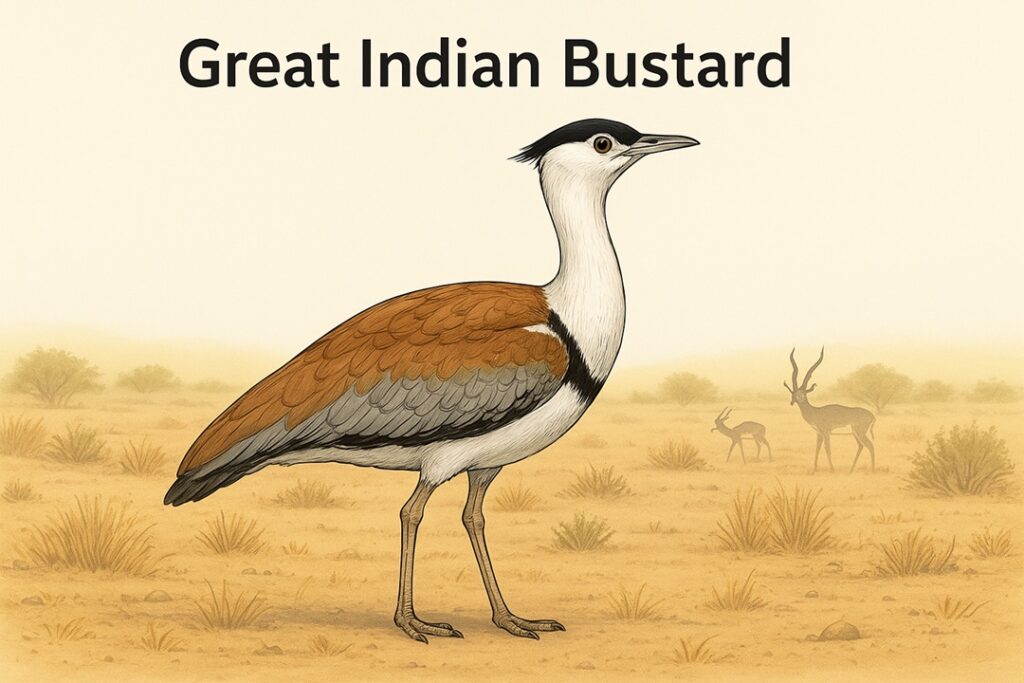“Saving the Great Indian Bustard: Beyond the Doctrine of Intergenerational Equity”

Context
The Great Indian Bustard (GIB) has come into national focus after Supreme Court Justice P.S. Narasimha observed that Western-origin environmental doctrines like intergenerational equity may be inadequate to protect critically endangered species. The observation highlights the importance of developing India-specific conservation approaches that reflect local ecological conditions and realities. The GIB’s situation exemplifies the urgent need for action-oriented strategies that combine legal frameworks with ground-level conservation efforts.
About the Great Indian Bustard
- One of the heaviest flying birds in the world, endemic to the Indian subcontinent
- Once widely distributed across India and Pakistan; now restricted to isolated populations
- Present habitats include the Thar Desert (Rajasthan), and parts of Gujarat, Maharashtra, and Karnataka
Habitat
- Inhabits arid and semi-arid grasslands with sparse vegetation
- Coexists with blackbuck and chinkara
- Nests on open, undisturbed plains, making it highly vulnerable to:
- Agricultural expansion
- Infrastructure projects like power lines and solar farms
- Poaching and human interference
Conservation Status
- IUCN Red List: Critically Endangered
- Wildlife (Protection) Act, 1972: Schedule I
- CITES: Appendix I
- CMS Convention: Appendix I
- Government Initiative: Covered under the Integrated Development of Wildlife Habitats (IDWH) species recovery programme
Physical Characteristics
- Height: About 1 metre; Weight: 15–18 kg
- Distinctive features include:
- Black crown, white neck and underparts, brown wings with grey and black patterns
- Males with black breast band and gular pouch that produces a booming mating call (audible up to 500 m)
- Diet: Omnivorous, feeding on grass seeds, insects, small reptiles, and rodents
About the Principle of Intergenerational Equity
- Ethical and legal doctrine ensuring sustainable use of resources by the present generation for future generations
- Emphasizes that humans act as trustees of Earth’s natural wealth, not absolute owners
- Serves as a foundational principle of sustainable development and global environmental law
Core Principles of Intergenerational Equity
- Trusteeship: Each generation must protect and preserve the planet as a shared trust
- Conservation of Options: Maintain diversity of natural resources for future choices
- Conservation of Quality: Preserve environmental quality—air, water, soil, and biodiversity
- Conservation of Access: Use resources equitably today without restricting access for future generations
Judicial Observation and Relevance
- Justice P.S. Narasimha’s remarks highlight the limitations of universal doctrines in addressing India’s unique ecological challenges
- Emphasizes the need for:
- Indigenous and localized conservation practices
- Greater community involvement in species protection
- Integration of science, law, and traditional knowledge
- Stronger implementation mechanisms for critically endangered species like the GIB
Conclusion
The case of the Great Indian Bustard reflects the challenges of applying global environmental doctrines to India’s diverse ecosystems. While intergenerational equity provides a strong ethical foundation, its effectiveness depends on region-specific conservation strategies. Protecting species like the GIB demands a holistic approach that combines legal safeguards, scientific innovation, and active local participation to secure India’s ecological future.
Source : The Hindu
